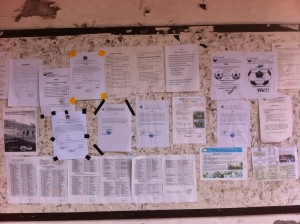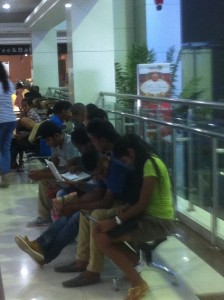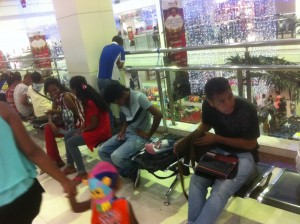In December 2014, I visited Dili on the occasion of a series of meetings dealing with the dissemination of the outcomes of the research project ‘Becoming a Nation of Readers: Language Policy and Adult Literacy Education in Multilingual Timor-Leste’, which was carried out by researchers from Tilburg University and Leiden University (the Netherlands), the University of Birmingham (United Kingdom) and the National University of Timor-Leste and the National Institute of Linguistics in Dili (Timor-Leste).
We went into the Timor Plaza shopping mall to look for an ATM and were confronted with a clear example of what I would propose to call new digital literacy sites, i.e., public places where digital literacy events and practices take place. The mall’s main entrance hall was filled with mainly young people. Sitting on benches, standing around alone or in groups, they were all working in one way or another on their mobile phones and lap tops, making full use of the (free) internet access that apparently was available there. Some were engaged in doing home work or assignments, others were looking at video clips and listening to the latest release of one or other international artist and still others were chatting, checking their e-mail, visiting Facebook or simply surfing on the internet. Similar gatherings can be witnessed in front of other public buildings like ministries with (free) internet access. I would suggest that such new digital literacy sites deserve full attention of literacy scholars, especially in developing countries of the Global South where internet access is not yet as widespread as in the Western world and where clear distinctions exist between digital haves and have-nots.
New digital literacy sites at Timor Plaza, December 2014 (© Sjaak Kroon)

Notice board National University of Timor-Leste, December 2014 (© Sjaak Kroon)
As with earlier literacy studies focused on the then newly discovered literacy sites such as the public notice boards I found on the campus of the National University of Timor-Leste, contemporary literacy studies should investigate these new digital literacy sites, and the new sociotechnical semiotic practices they involve as part of the linguistic landscape. Questions to be explored include: where can such new digital literacy sites be found; what are the (linguistic, cultural, socio-economic) characteristics of people engaged in digital literacies; what languages and/or combinations of languages and what scripts are used in digital literacy practices; what about linguistic normativity in digital literacy practices; what are the topics dealt with in digital literacy practices; what networks are people linked to when engaging in digital literacy practices; what about commercial and financial aspects of digital literacy practices; how can digital literacy practices be used for teaching and learning, e.g., for becoming literate; how does analog compare to digital literacy skills of those visiting and using new digital literacy sites?
Sjaak Kroon

